Having set the scene with Velázquez’s unusual painting of a young woman who could be a sibyl, or an allegory of painting, I come to look in detail at his Las Hilanderas, which he painted for an unknown patron before he travelled to Italy for his second visit. Before looking at the work, let me refresh your memory with the myth of Arachne and the weaving contest.
Arachne, in Roman legend, was described in three different accounts, of which Ovid’s, in his Metamorphoses, is probably the most popular and appropriate here: we know, for example, that Velázquez had three versions of this retold in Spanish, although any differences between those versions and Ovid’s original are not clear. Unusually, this myth was Roman in origin, and there is no trace of it in the surviving Greek literature, nor has it been found in Greek vase paintings.
Arachne was the daughter of a humble family, whose mother had died, but her father had started as a shepherd and become a dyer of wool in purple. Arachne became the greatest weaver in the world, and boasted that her skill was greater than that of the goddess (Pallas) Athena. The latter set up a contest between them, posing as an old woman who then challenged Arachne before revealing herself.
Unfortunately for Arachne, she not only produced work more beautiful than Athena’s, but it showed the many lapses of the gods and their unfairness to mankind. Athena was enraged by this, ripped Arachne’s work to shreds, and sprinkled her with Hecate’s potion, which turned her into a spider. She and her kin were thus condemned to weave for all time.
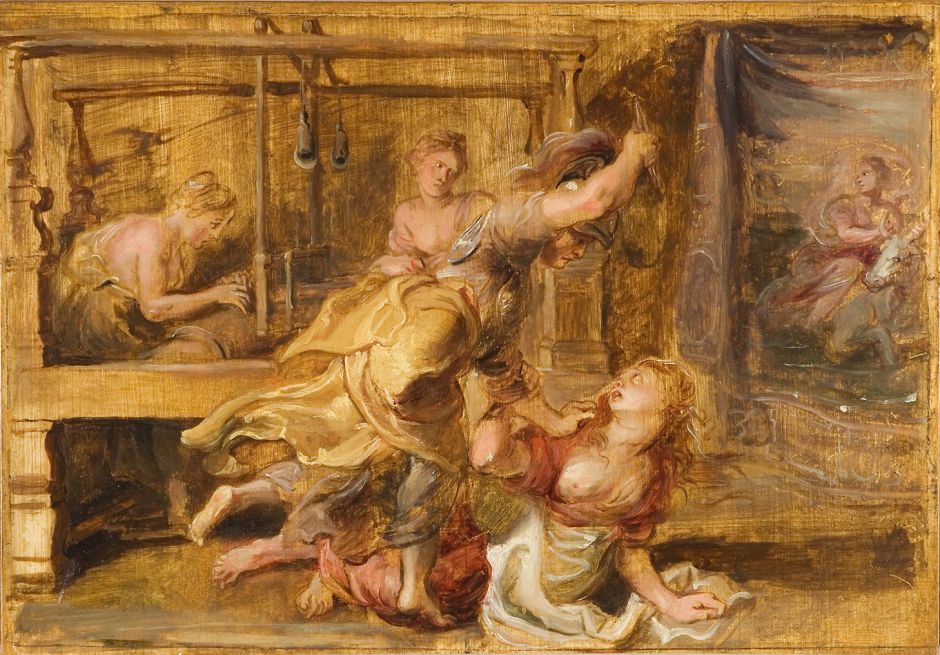
This was painted slightly earlier by Rubens, in his Pallas and Arachne (1636-37), which clearly shows the weaving contest, with Pallas Athena striking Arachne with her boxwood shuttle in front of the looms. Behind is a clear visual reference to the Rape of Europa in the tapestry to the right.
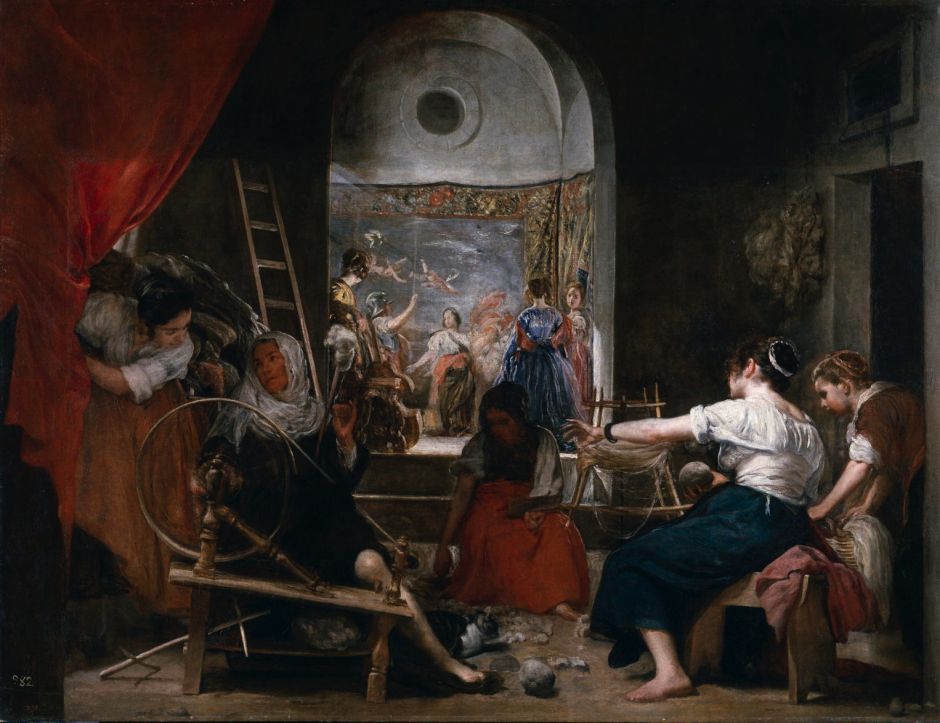
The snag with that reading is that it does not fit what the painting actually shows: the older woman at the left is not weaving but spinning, using a spinning wheel which would also have been a gross anachronism at the time of Arachne’s contest.
Ovid’s account is also clear in stating that, before the contest started, Athena revealed herself in her full glory, and did not retain the appearance of an old woman. Furthermore, the woman on the right is not weaving either, but is winding spun yarn into skeins. Neither is there any evidence in the foreground of the presence of any dyed yarn which might be suitable for weaving.
Barolsky (2014) recognises that the women in the foreground are not weaving, but still maintains that the tapestry of The Rape of Europa in the background “conjures up the story of the competition between Arachne and Minerva”. He too considers the woman at the spinning wheel must be Athena/Minerva, as well as the woman in the background wearing a helmet, which makes the painting have multiplex or continuous narrative (a composite of two temporally distinct scenes). That would, of course, be unusual for Velázquez, and for a painting of this time.
However, Velázquez had used multiplex narrative at least once before, in his Saint Anthony Abbot and Saint Paul the Hermit from about 1635-38.
The difficulties in these readings have been recognised by Giles Knox (2009), who maintains that the foreground and background tell different but related stories with the common theme of the craft of painting.
The most remarkable reading is that of Wendy Bird (2007), who accepts that the foreground figures have nothing to do with weaving, but are “engaged in carding, spinning and winding yarn”. She then proceeds to argue that the painting contains earthy erotic imagery referring to lust and prostitution.

- a young woman, bending down from a position against a pile of fabrics and materials;
- an older, but by no means old, woman holding a distaff and operating a spinning wheel to spin wool. She is dressed very modestly, with her hair covered, but her left leg is bare from the knee down to her bare foot;
- a woman sat low, carding wool. Her face is dark and lacks features;
- a younger woman with her back to the viewer, who is winding wool with her left hand, and holds a ball of undyed wool in her right. She appears to have removed some of the clothing from her upper body, which is clad in (very modest) undergarments;
- at the right edge, a girl who appears to be observing or assisting the fourth woman, and rests on a wicker basket.
There is also a cat, at the second woman’s feet, and fleeces hanging at the top right.

The second woman, although apparently older than the others, does not meet Ovid’s description of having “long grey hair, and with a staff to steady her weak limbs. She seemed a feeble woman, very old, and quavered as she” spoke.
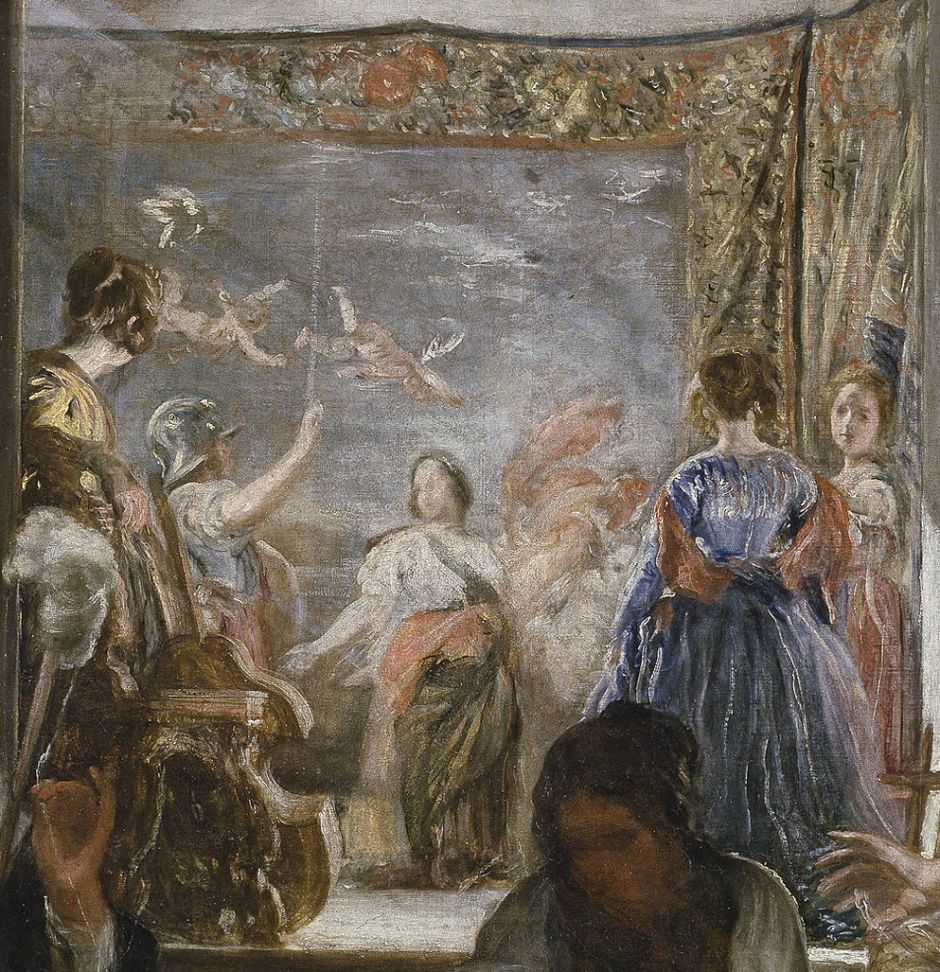
- a well-dressed woman facing away from the viewer, her right hand resting near a viola da gamba (the size of a modern cello);
- a person (of indeterminate gender) wearing a helmet and upper body armour, facing away from the viewer, and probably holding a spear in her right hand, although this is now marked only by a vertical white line;
- a woman whose right forearm is outstretched, engaged apparently with the second woman, and facing towards her;
- a well-dressed woman, standing with her back to the viewer, apparently looking towards the fifth woman;
- another well-dressed woman, seen side-on but looking directly at the viewer.
None of these people are engaged in any form of weaving or wool-working, and the musical instrument is not being played.
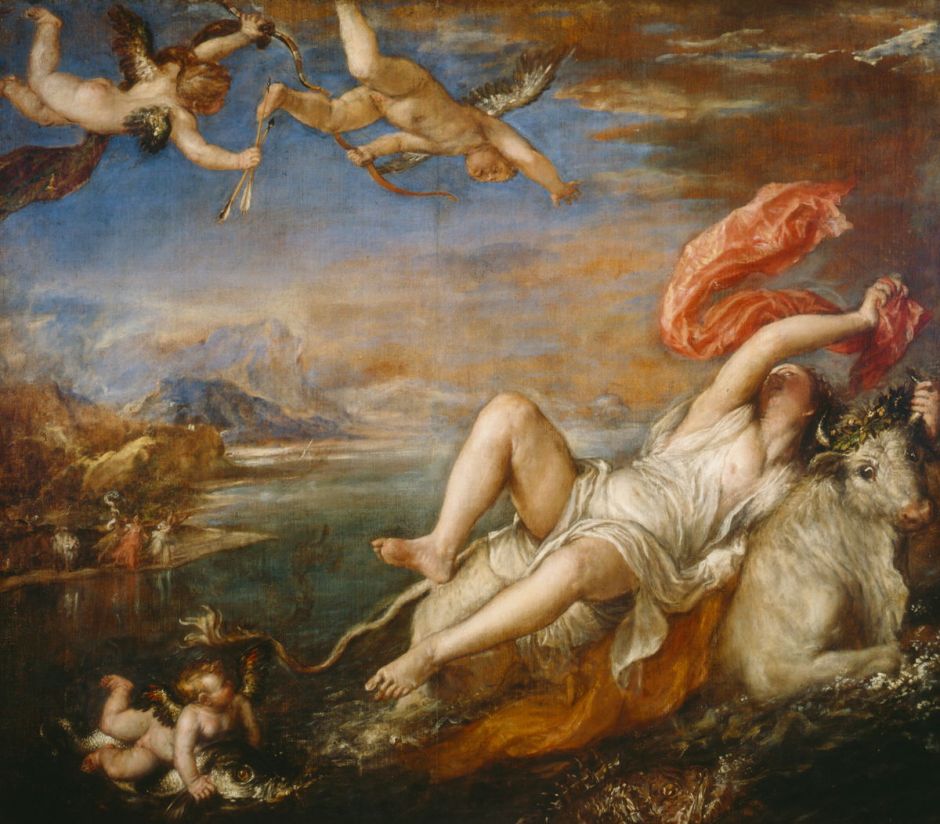
Behind them, and close by the third woman, is an ornately-edged tapestry showing the same image as Titian’s painting The Rape of Europa (1560-62), above, or its near-identical copy made by Rubens in 1628-29 (below). At the time that Rubens made that copy, he and Velázquez were together at the royal court in Madrid, but Rubens is believed to have taken his copy back to Antwerp with him in 1629. Velázquez therefore most probably only had access to Titian’s original when he was painting Las Hilanderas.
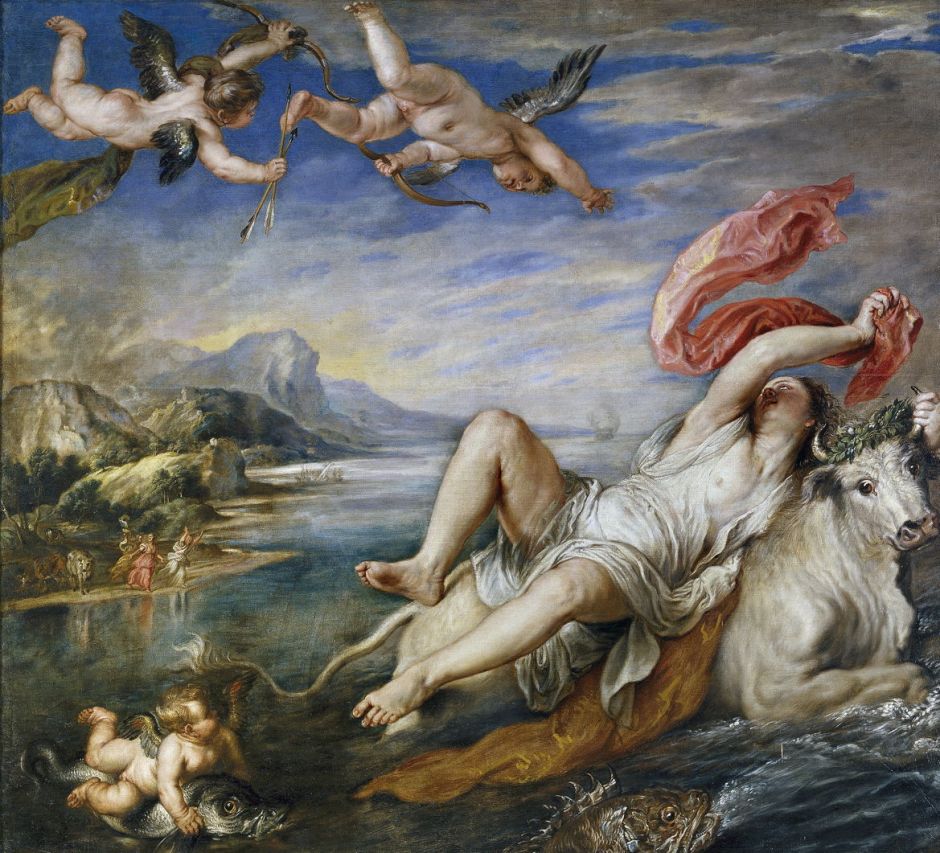
These paintings are so similar that it is immaterial as to which Velázquez may have used as the basis for this painting.
The second person may be intended to represent Pallas Athena, as her helmet and armour are possibly characteristic. I write “possibly”, because the strongest tradition shows her helmet with exuberant decoration along its midline.
There are no other references to the story of Arachne – such as a spider, spider’s web, etc. – nor to the Fates. The figures shown are not in any form of altercation, nor is the second person wielding a boxwood shuttle, tearing down or up any tapestry, nor showing any of the behaviours described by Ovid.
Putting it together
Velázquez was not a prolific painter of classical myths, but he has a well-deserved reputation for constructing complex paintings which can be read at several different levels, and are quite intensely cerebral – his most famous Las Meninas (1656) is a good example which continues to generate much speculation.
Attempts to suggest a simple reading, in terms of wool-working or Ovid’s story, simply don’t correspond with what is actually shown in the painting. Instead we need to look at each of the references made by Velázquez, their meanings, and how they might assemble into a coherent whole. Although this approach was mentioned by Wendy Bird (2007), she considered that the “interpretations of the fable of Arachne” “seem unrelated to” the painting.
Arachne’s crimes, in the eyes of Pallas Athena, were to criticise the gods in her art, and to be conceited enough (perhaps justly) to claim that she was better than the gods in that art. The image of the rape of Europa is particularly appropriate to the former reason, and particularly relevant to any artist late in their career, when they are looking back at what they created, and passing on advice to future generations.
I don’t believe that Velázquez uses the spinning workshop in the foreground as a reference to Arachne (although Ovid did briefly mention Arachne’s spinning in his laudatory introduction to her weaving skills), nor to time (the Fates are not being cited), nor to sexual promiscuity (which appears out of kilter with the whole painting).
Rather the spinners represent the craft foundation for the tapestry art, both in material terms, and in providing the content through which the art is expressed. This is almost a meta-narrative in defence of narrative painting, and the fundamental craft basis for the art. It also isn’t too distant from Giles Knox’s reading.
I think that this was Velázquez looking back at his career, passing on its lessons to artists of the future, and posing us a visual riddle.

Wikipedia on this painting.
An English translation of the story of Arachne, quoted from above, is in Tufts’ superb Perseus digital library. The translation is taken from: Ovid, Metamorphoses, by Brookes More. Boston. Cornhill Publishing Co. 1922.
Barolsky P (2014) Ovid and the Metamorphoses of Modern Art from Botticelli to Picasso, Yale UP. Pages 147-8. ISBN 978 0 300 19669 6.
Bird W (2007) The bobbin & the distaff: erotic imagery and the meaning of Velazquez’s ‘Las Hilanderas’, Apollo Magazine.
Jonathan Brown and Carmen Garrido (1998) Velázquez, the Technique of Genius, Yale UP. ISBN 978 0 300 10124 9.
Kilinski K II (2013) Greek Myth and Western Art, The Presence of the Past, Cambridge UP. Page 138. ISBN 978 1 107 01332 2.
Giles Knox (2009) The Late Paintings of Velázquez, Theorizing Painterly Performance, Ashgate/Routledge. ISBN 978 1 138 27464 8.
José López-Rey and Odile Delenda (2014) Velázquez The Complete Works, Taschen and the Wildenstein Institute. ISBN 978 3 8365 5016 1.

